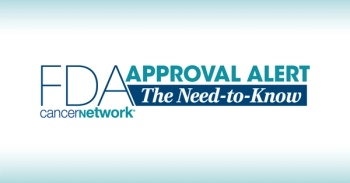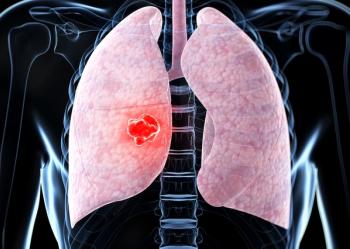
- ONCOLOGY Vol 39, Issue 7
- Volume 39
- Issue 7
- Pages: 298-300
Unveiling the Potential of Zenocutuzumab: A Breakthrough in NSCLC and Pancreatic Adenocarcinoma Treatment
Zenocutuzumab offers a targeted treatment for NRG1+ lung and pancreatic cancers, demonstrating promising efficacy and manageable adverse effects.
Introduction
Lung cancer remains the leading cause of cancer-related deaths in the United States.1 Non–small cell lung cancer (NSCLC) accounts for approximately 85% of all lung cancers.2 In the past decade, significant advances have been made in the management of NSCLC, including improvements in screening and targeted therapies. The National Lung Screening Trial demonstrated a 20% reduction in lung cancer mortality and a 6.7% decrease in all-cause mortality with the use of low-dose CT.3 The treatment of NSCLC has evolved with the introduction of targeted therapies, such as tyrosine kinase inhibitors for EGFR, ALK, ROS1, and NTRK mutations, as well as immune checkpoint inhibitors.4
Pancreatic ductal adenocarcinoma (PDAC) remains one of the most fatal malignancies due to late-stage diagnosis and limited therapeutic options. The current standard treatments, including gemcitabine-based regimens and folinic acid, fluorouracil, irinotecan, and oxaliplatin (FOLFIRINOX), have shown limited efficacy and substantial toxicity.5There is an urgent need for more effective therapies with improved tolerability. NRG1 fusions are rare oncogenic drivers detected in NSCLC, PDAC, and other solid tumors, occurring in less than 1% of cases.6 Patients with NRG1 fusion–positive (NRG1+) cancers have limited treatment options.
Mechanism of Action
Zenocutuzumab is a bispecific immunoglobulin (Ig) G1 antibody targeting HER2 and HER3, blocking NRG1 binding via a “dock and block” mechanism.7 The Figure illustrates the dual mechanism of zenocutuzumab in targeting HER2 and HER3, blocking oncogenic signaling pathways in NSCLC and pancreatic adenocarcinoma to inhibit tumor growth and survival.
The HER2-targeting arm enhances local concentration, whereasthe HER3-targeting arm blocks NRG1 binding, preventing heterodimerization with HER2 and EGFR. This inhibition suppresses HER3 phosphorylation and downstream oncogenic signaling. Additionally, glycoengineered modifications enhance antibody-dependent cellular cytotoxicity.8 Zenocutuzumab’s mechanism has been validated in preclinical models of NSCLC and breast, pancreas, and ovarian cancers harboring NRG1 fusions. Clinical efficacy has been demonstrated in patients with NRG1+ lung and pancreatic cancer, supporting its use across multiple tumor types.9
Efficacy of Zenocutuzumab
Efficacy was assessed in the phase 2 eNRGy study (NCT02912949), a multicenter, open-label trial enrolling adults with advanced/metastatic NRG1+ NSCLC and PDAC that had progressed after standard therapy. NRG1 fusions were identified via next-generation sequencing.7 The primary efficacy end points were overall response rate (ORR) and duration of response (DOR), evaluated per RECIST v1.1 by blinded independent review, as follows:
NSCLC:
• ORR: 33% (95% CI, 22%-46%)
• Median DOR: 7.4 months (95% CI, 4.0-16.6)10
Pancreatic adenocarcinoma:
• ORR: 40% (95% CI, 23%-59%)
• DOR: range, 3.7-16.6 months10
The recommended zenocutuzumab dose is 750 mg intravenously every 2 weeks until progression or toxicity.11
Additional efficacy data from the extended access program reinforce zenocutuzumab’s clinical benefit. Among 51 patients treated (NRG1+ across various cancers), the disease control rate reached 90% in pancreatic cancer, and tumor regression was observed in 76% of patients with NSCLC. Zenocutuzumab demonstrated efficacy even in patients previously treated with afatinib, highlighting its role as a viable treatment option for refractory NRG1+ cancers. 10
Safety of Zenocutuzumab
Zenocutuzumab was generally well tolerated. The most common adverse effects (≥ 10%) included the following:
• Gastrointestinal symptoms: diarrhea, nausea, vomiting, abdominal pain
• Systemic symptoms: fatigue, musculoskeletal pain, edema
• Respiratory symptoms: dyspnea
• Dermatologic symptoms: rash
Severe (grade 3/4) laboratory abnormalities (≥ 10%) included elevated gamma-glutamyl transferase, decreased hemoglobin, hyponatremia, and thrombocytopenia. Importantly, no significant cardiotoxicity or severe gastrointestinal/skin toxicity was reported.7,11
Conclusion
Zenocutuzumab represents a promising therapy for patients with NRG1+ NSCLC and PDAC, offering a targeted approach with manageable toxicity. Its bispecific HER2/HER3 blockade disrupts oncogenic NRG1 signaling, providing durable responses in a subset of patients. The ongoing eNRGy trial continues to evaluate its broader application in solid tumors.
Corresponding Author
Abdul Baseer Wardak, MBBS
Institution: Razia Bahlol Hospital, Kabul, Afghanistan
Phone: +93 79 542 1983
Email: a.baseer21@gmail.com
Address: Madina Township Kabul, Afghanistan
ORCID id: 0000-0002-9929-6088
Author contributions
The conceptualization was done by MHG and ABW. The literature and drafting of the manuscript were conducted by AW, UF, and ZI. The editing and supervision were performed by MKB, AA, and SR. All authors have read and agreed to the final version of the manuscript.
References
- Duma N, Santana-Davila R, Molina JR. Non-small cell lung cancer: epidemiology, screening, diagnosis, and treatment. Mayo Clin Proc. 2019;94(8):1623-1640. doi:10.1016/j.mayocp.2019.01.013
- Gul MH, Wardak AB, Waheed A. Navigating a paradigm shift; food and drug administration approved tarlatamab-dlle redefining the landscape of small cell lung cancertherapy. Int J Sci Rep. 2024;10(8):303-304.doi:10.18203/issn.2454-2156. IntJSciRep20241995
- de Koning HJ, van der Aalst CM, de Jong PA, et al. Reduced lung-cancer mortality with volume CT screening in a randomized trial. N Engl J Med. 2020;382(6):503-513. doi:10.1056/NEJMoa1911793
- Gainor JF, Shaw AT. Emerging paradigms in the development of resistance to tyrosine kinase inhibitors in lung cancer. J Clin Oncol. 2013;31(31):3987-3996. doi:10.1200/JCO.2012.45.2029
- Mashayekhi V, Mocellin O, Fens MHAM, Krijger GC, Brosens LAA, Oliveira S. Targeting of promising transmembrane proteins for diagnosis and treatment of pancreatic ductal adenocarcinoma. Theranostics. 2021;11(18):9022-9037. doi:10.7150/thno.60350
- Jones MR, Lim H, Shen Y, et al. Investigations of targeted therapies for NRG1 fusion–positive cancers (no date) Targeted Oncology. Available at: https://www.targetedonc.com/view/investigations-of-targeted-therapies-for-nrg1-fusion-positive-cancers.
- Kim DW, Schram AM, Hollebecque A, et al. The phase I/II eNRGy trial: zenocutuzumab inpatients with cancers harboring NRG1gene fusions. Future Oncol. 2024;20(16):1057-1067.doi: 10.2217/fon-2023-0824
- Schram AM, Odintsov I, Espinosa-Cotton M, et al. Zenocutuzumab, a HER2xHER3 bispecific antibody, is effective therapy for tumors driven by NRG1 gene rearrangements. Cancer Discov. 2022;12(5):1233-1247. doi:10.1158/2159-8290.CD-21-1119
- Shin DH, Jo JY, Han JY. Dual targeting of ERBB2/ERBB3 for the treatment of SLC3A2-NRG1-mediated lung cancer. Mol Cancer Ther. 2018;17(9):2024-2033. doi:10.1158/1535-7163.MCT-17-1178
- Schram AM, Goto K, Kim DW, et al. Efficacy of zenocutuzumab in NRG1fusion-positive cancer. N Engl J Med. 2025;392(6):566-576. doi:10.1056/NEJMoa2405008
- FDA grants accelerated approval to zenocutuzumab-zbco for non-small cell lung cancer and pancreatic adenocarcinoma, FDA. December 4, 2024. Accessed May 27, 2025. http://tinyurl.com/rpwmb5yn
Articles in this issue
Newsletter
Stay up to date on recent advances in the multidisciplinary approach to cancer.





